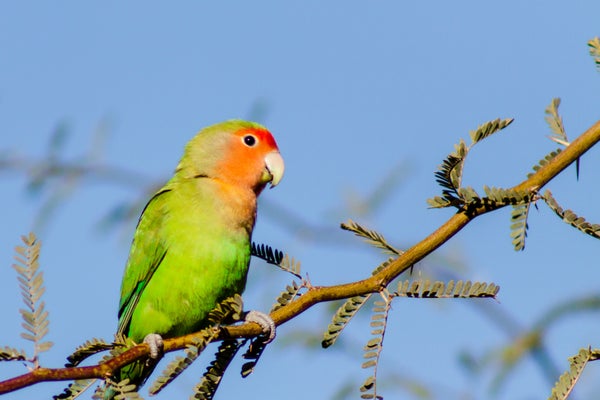“For probably most of a decade, it seemed to be during the hot summertime where my students would come back into the building and knock on my door and say, ‘Hey, did you see the lovebirds on the windows and the vents?’ I’d say, ‘Yeah, I have.’ And they’d say, ‘What do you think they’re doing? Why are they there? Maybe they're cooling down or avoiding something.’ And I said, ‘That sounds really interesting. Maybe we should do a study on it.’”
Arizona State University biologist Kevin McGraw typically studies the way animals, including birds, use color as a way to communicate. But he couldn’t resist the avian mystery just outside his office door. After hearing about the birds perching on campus buildings year after year, he decided to enlist the help of some undergraduate students to figure out what they were up to.
Rosy-faced lovebirds are a type of parrot native to the arid parts of southwest Africa, like Namibia’s Namib Desert. Probably due to the pet trade, it became established in Phoenix, Arizona, around 35 years ago. In their native range, they usually stick to natural areas, but in Phoenix, they seem to prefer urban areas like the ASU campus.
On supporting science journalism
If you're enjoying this article, consider supporting our award-winning journalism by subscribing. By purchasing a subscription you are helping to ensure the future of impactful stories about the discoveries and ideas shaping our world today.
“It’s the hottest city in North America here in Phoenix, and there aren’t a lot of micro sites natively in the desert where you can hide or, in this case, cool down.”
Some of the older buildings on campus have inefficient cooling systems that release cooled air into the environment. It’s bad for energy efficiency, but good for the birds.
Even though rosy-faced lovebirds live in Phoenix year-round, the researchers found that they seek out the air conditioning relief vents only between June and October. And they’re most likely to do it on the hottest days that exceed 99 degrees Fahrenheit. The results were published in the journal Biology Letters. [Raegan Mills and Kevin J. McGraw. Cool birds: Facultative use by an introduced species of mechanical air conditioning systems during extremely hot outdoor conditions]
Even this desert-adapted bird has a thermal tolerance limit, and the sweltering Phoenix summer – exacerbated by the urban heat-island effect – often surpasses it.
These obviously aren’t the first animals to take advantage of the built environment. Plenty of birds seek out buildings for nesting or roosting, for example. But in those cases, the built environment is providing a replacement for a natural habitat that’s gone missing.
That’s not quite what’s happening here, says ASU undergraduate student Raegan Mills, who led the study.
“It wasn’t that they were just moving into these spaces because the previous spaces that were there had been taken away. It was: they are finding this interesting new opportunity to serve some sort of thermoregulatory function.”
The researchers say this may be the first formal documentation of an animal population taking advantage of building infrastructure for cooling.
“The big takeaway is our human responsibility when it comes to the rise in global temperatures. We’re pushing these animals to adapt to that in really novel, interesting ways. Wild birds don’t typically like to be close to people.”
Once the pandemic restrictions allow them to return to campus, Mills and McGraw hope to continue their study of these birds. One thing they’d like to understand is whether the introduced lovebirds are outcompeting native birds for access to this cooling resource or whether native species have found other strategies for surviving the hottest days.
“We have, I think, a pretty significant moral responsibility to understand the ways that we’re causing animals to interact with us.”
—Jason G. Goldman
[The above text is a transcript of this podcast.]

